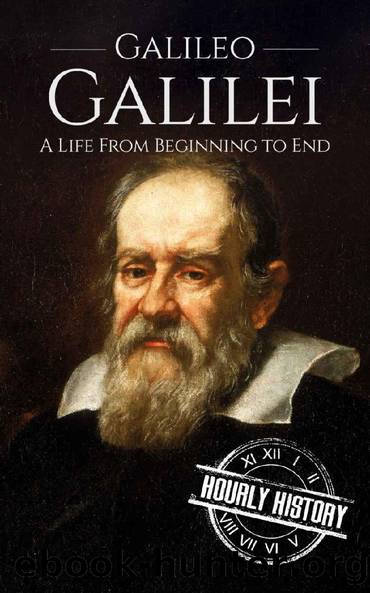Galileo Galilei: A Life From Beginning to End (Biographies of Physicists Book 3) by Hourly History

Author:Hourly History [History, Hourly]
Language: eng
Format: epub
Publisher: Hourly History
Published: 2017-06-20T00:00:00+00:00
Chapter Seven
Controversial Theories
âI think great artists and great engineers are similar, in that they both have a desire to express themselves.â
âSteve Jobs
Galileo put forth many correct theories about the heavens. But, he wasn't always right. One of those times was in 1618 when three comets came into sight, and he became involved in their appearance. He believed that the comets were close to the Earth and caused by optical refraction or a change in light waves due to a change in their transmission.
Trouble seemed to loom on the horizon for Galileo. The more he argued, the more he made himself an enemy of the Jesuits. Then, in 1619, Galileo found himself embroiled in an argument with Father Orazio Grassi who was a professor of mathematics at the Jesuit Collegio Romano. At first, it was nothing more than a disagreement about the nature of comets, but in a few years had escalated to something more.
Earlier that year, Father Grassi had also published a pamphlet anonymously titled An Astronomical Disputation on the Three Comets of the Year 1618. The previous year, in November, to be exact, a comet had appeared in the night sky. Grassi had concluded that this comet was a fiery body which moved along at a great distance from the Earth. Because it moved in the sky more slowly than the moon, Grassi said it must be farther away than the Moon.
Grassi's conclusions were criticized by one of Galileo's followers, a lawyer from Florence, one Mario Guiducci. Galileo and Guiducci didn't offer any theory of their own regarding comets, although they did throw out some ideas, which are now known to be mistaken.
Galileo and Guiducci had published a work called Discourse on the Comets, where their theories were made known. In addition to this, the authors also made uncomplimentary remarks about the professors at the Collegio Romano. The Jesuits were offended, to say the least, and Grassi followed up with a tract of his own entitled The Astronomical and Philosophical Balance.
By this time, Galileo had also published The Assayer, and in it, he takes apart Grassi's arguments one by one. Many people loved this tract and the pope, Urban VIII, was a particular fan. Now, Galileo had permanently alienated many of the Jesuits who had formally been on his side. He always believed that it was the Jesuits who brought about the condemnation he suffered in later years.
From 1618 and on into the next decade, Galileo tried to stay far away from further controversies. He decided to write a book on the subject of heliocentrism anyway because the Pope was a good friend of his, and someone who he believed would be on his side.
As time went on, Galileo's health was declining, and he was having frequent bouts of severe illness. By 1624, Galileo started writing his book, his famous Dialogue Concerning the Two Chief World Systems. In 1630, when his work was finally completed, Galileo even requested permission from Rome to publish the book, but it was not an easy task.
Download
This site does not store any files on its server. We only index and link to content provided by other sites. Please contact the content providers to delete copyright contents if any and email us, we'll remove relevant links or contents immediately.
Blood and Oil by Bradley Hope(1531)
Wandering in Strange Lands by Morgan Jerkins(1374)
Ambition and Desire: The Dangerous Life of Josephine Bonaparte by Kate Williams(1347)
Daniel Holmes: A Memoir From Malta's Prison: From a cage, on a rock, in a puddle... by Daniel Holmes(1295)
It Was All a Lie by Stuart Stevens;(1265)
Twelve Caesars by Mary Beard(1258)
The First Conspiracy by Brad Meltzer & Josh Mensch(1140)
What Really Happened: The Death of Hitler by Robert J. Hutchinson(1131)
London in the Twentieth Century by Jerry White(1114)
Time of the Magicians by Wolfram Eilenberger(1091)
The Japanese by Christopher Harding(1086)
Twilight of the Gods by Ian W. Toll(1085)
Cleopatra by Alberto Angela(1063)
A Woman by Sibilla Aleramo(1055)
Lenin: A Biography by Robert Service(1046)
The Devil You Know by Charles M. Blow(987)
Reading for Life by Philip Davis(974)
1965--The Most Revolutionary Year in Music by Andrew Grant Jackson(925)
The Life of William Faulkner by Carl Rollyson(925)
